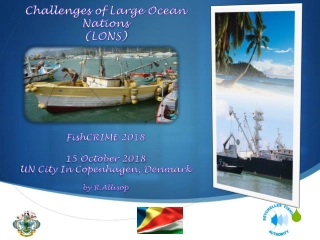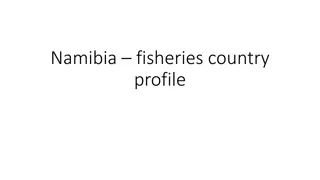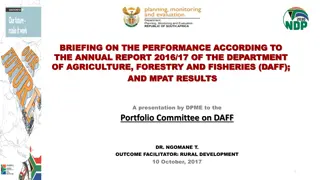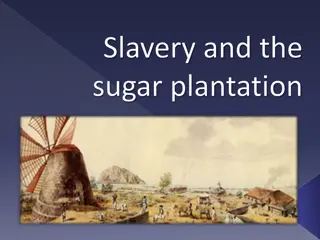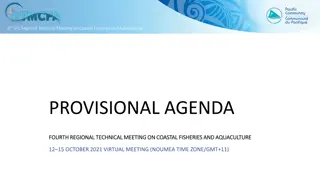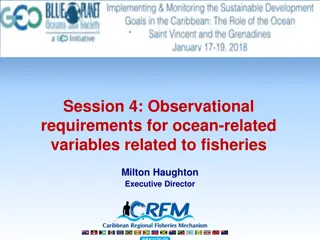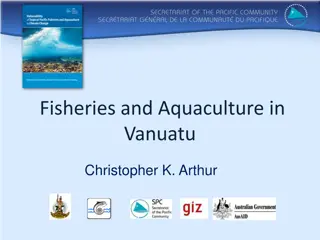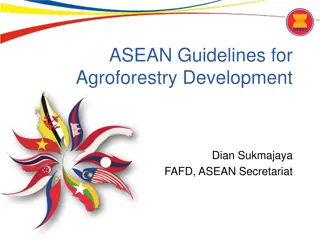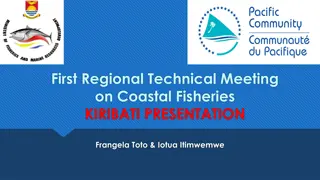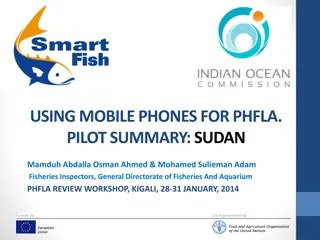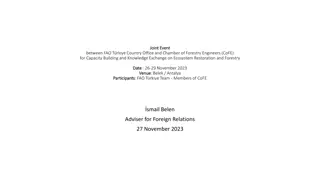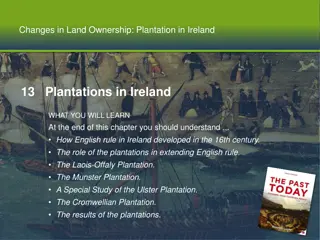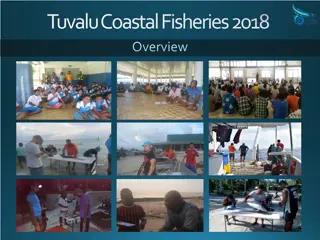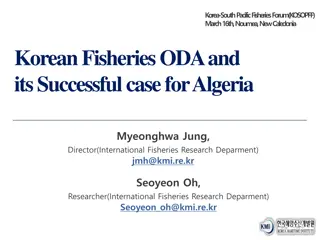Restructuring of State Managed Plantations by Department of Environment, Forestry, and Fisheries
The transfer of the Department of Environment, Forestry, and Fisheries (DEFF) state managed plantations on 20th October 2020 involves restructuring processes, privatisation of plantations, community involvement, and the future management models for different categories of plantations. The background includes policies for sustainable forest development and the need for disposal of industrial forests while ensuring community rights. Various acronyms such as DEFF, CFA, MTO, and NFA are explained, along with details on plantations managed by DEFF across different provinces in South Africa.
Download Presentation

Please find below an Image/Link to download the presentation.
The content on the website is provided AS IS for your information and personal use only. It may not be sold, licensed, or shared on other websites without obtaining consent from the author.If you encounter any issues during the download, it is possible that the publisher has removed the file from their server.
You are allowed to download the files provided on this website for personal or commercial use, subject to the condition that they are used lawfully. All files are the property of their respective owners.
The content on the website is provided AS IS for your information and personal use only. It may not be sold, licensed, or shared on other websites without obtaining consent from the author.
E N D
Presentation Transcript
TRANSFER OF THE DEPARTMENT OF ENVIRONMENT, FORESTRY AND FISHERIES STATE MANAGED PLANTATIONS 20 OCTOBER 2020
TABLE OF CONTENTS 1. Acronyms 2. Background 3. Plantations managed by DEFF 4. Future Management Models 5. Role of forestry post transfer 6. Concluding Remarks 2
ACRONYMS DEFF Department of Environment, Forestry and Fisheries CFA Community Forestry Agreement MTO Mountain to Oceans NFA National Forests Act PPGI Public Private Growth Initiative PPP Public Private Partnership SAFCOL South African Forestry Company Limited SMEs Small, Micro and Medium Enterprises TUP Temporarily Unplanted Area 3
BACKGROUND White Paper on Sustainable Forest Development (1996) recommended that the State must withdraw from the management of plantations. It further states that there is a need to dispose of the industrial forests and community woodlots and forests in the most beneficial way, after proper and full consultation . The policy also calls for strong protective measures for communities with land rights and land claims on state forests. Furthermore, Section 22 (1) of the National Forests Act, stipulates that the rights to the use, management, control and operation of; and the forest produce in, State forests, vest in the national executive of the Republic, represented by the Minister. 4
BACKGROUND The implementation of the above policies led to the commencement of the restructuring process in 2001 which identified three categories of plantations: Categories A, B and C. In 2001, Category A plantations were privatised and grouped into five business packages. Four of the five business packages were sold to private companies (Siyaqhubeka, Singisi, MTO and Amathole with the last package, Komatiland, still remaining with SAFCOL). The land is leased for 70 years. Small- and medium-sized plantations (Category B), considered suitable for management by small to medium enterprises were left under DAFF s management to be restructured as a second phase. Woodlots (Category C plantations) situated mainly in the former homelands, which were not suitable for industrial management were also left under DAFF s management to be transferred directly to communities. The remaining category B and C plantations fall within the ambit of the NFA and their transfer/disposal should be dealt with in terms of Government s restitution and tenure reform policy 5
PLANTATIONS MANAGED BY DEFF PROVINCE CATEGORY A (ha) - CATEGORY B (ha) 18 636 CATEGORY C (ha) 9 182.08 TOTAL AREA (ha) 27 818.08 NUMBER OF EMPLOYEES 424 EASTERN CAPE KWAZULU- NATAL LIMPOPO MPUMALANGA WESTERN CAPE - 25 720.66 356 26 076.66 216 - - 22 000 2 732.77 4 092.20 - 1 316.49 - - 4 049.26 4 092.20 22 000 118 169 0 22 000 51 181.63 11 053.87 84 235.5 931 7
CURRENT STATUS OF THE PLANTATIONS These plantations are not economically viable due to the fact that they are operating below capacity and do not meet the forestry industry standards and norms. There is a high rate of temporary unplanted areas Dilapidated infrastructure Non-compliance with legislation The above is attributable to limited budget and lack of capacity due to an aging and ailing work force, timber theft, veldfires, pests and diseases 8
PURPOSE OF THE FUTURE MANAGEMENT MODEL/S The purpose is to develop the models that are capable of changing the current status of plantations into plantations that are economically viable and/or sustainable. To develop a strategic tool which will enable DEFF to withdraw from the day-to-day management of plantations and assume regulation role as outlined by the White Paper on Sustainable Forest Development (1996). Objectives of the model will be to: Promote sustainable forest management; Contribute to rural development and improve livelihoods; Improve production and economic viability in the plantations by reducing TUPs; Job creation and contribution to the GDP; and Contribute to the transformation of the sector. The transfer of the plantations will kick-start the implementation of the Commercial Forestry Sector Masterplan, once approved by Cabinet. 9
COMMERCIAL FORESTRY SECTOR MASTERPLAN Main objective is to achieve growth and investment within the sector in line with the PPGI Identified 7 Key Focus Areas Expansion of primary resources, maintenance and protection Transformation of the sector Processing and value addition Illegal timber and related criminal activities Research, Development and Innovation and Human Resource and Skills Development Key Inhibitors Institutional Development Department to prioritise Key Focus Area 1 focus on release of Category B & C plantations and leasing of Category A plantations 10
GUIDING PRINCIPLES FOR THE RELEASE OF CATEGORY B&C PLANTATIONS No change in land use Recognition of people s rights Compliance with laws Consultation The principles of sustainable forest management as stipulated in section 3(3) of the National Forests Act must be applied. Define role of DEFF reference to the White Paper and the Post Settlement Support Framework No model is suitable for all plantations avoiding blanket approach and appreciating the uniqueness of different areas. Youth and women enterprise development 11
DIFFERENT TYPES OF MANAGEMENT MODELS Having investigated and consulted extensively regarding the restructuring of Category B and C plantations, three models were considered, namely: Public-Private Partnership in line with PFMA and Treasury Regulations Management by other state organs according to Section 48 of the National Forests Act, 1998 Community Forestry Agreements - according to Section 29 of the National Forests Act, 1998. Consultations on these models were done widely with stakeholders where industry and small growers mainly preferred PPP and communities preferred the Community Forestry Agreements. 12
PUBLIC PRIVATE PARTNERSHIPS PPP s are a contract between a public institution and a private partner. They are administered through the PFMA, Treasury Regulations and Municipal Finance Management Act. PPP s can take different forms namely: Lease The operator takes the risk and the authority is paid a lease fee and the process is reviewed generally every 4-5 years Privatisation- Partial or all the interest of government in a utility asset is transferred to the private sector Joint Venture - A contracting authority has an equity stake in the project. A new holding company is created 13
PUBLIC PRIVATE PARTNERSHIPS ADVANTAGES DISADVANTAGES Given the long term of the project, it is difficult to identify all possible contingencies, issues that might arise at the time of signing the contract Financial, operational and maintenance risks are for the company. Company invests its own money to expand the project. A way of gradually exposing SOE and government to increasing levels of private sector involvement. Value for money Competition Change in government policy may cause the project to be terminated before agreed time 14
COMMUNITY FORESTRY AGREEMENT (CFA) Community Forestry Agreement (CFA) is concluded in terms of section 29 to 31 of the National Forests Act, 1998. These sections allow for communities that wish to engage in community forestry to make an offer to the Minister to enter into a CFA whereas on the other hand it also allows for the Minister to invite communities to submit offers to enter into CFAs in respect of a particular State forest or forests. ADVANTAGES DISADVANTAGES Lack of technical skills Potential to create conflicts within beneficiaries Lack of funding Weak post settlement support Lessons drawn from previous agreements can be used as a case study NFA provides a clear guideline on the formation of CFA Potential for expansion and merging with new afforestation areas Empowerment of the beneficiaries 15
MANAGEMENT BY ORGAN OF STATE Section 48 (c) of the National Forest Act, 1998 state that the Minister may delegate the exercise of any of her powers, other than a power referred to in subsection (4), and the performance of any of her duties, to (c) an organ of State . ADVANTAGES DISADVANTAGES Experience in management of government assets Strengthens vertical integration. Experience in dealing with land restitution issues. There is an opportunity to transfer staff Provides good job opportunities for local communities Vast expertise and experience in sustainable management of assets for economic, social and Environmental sustainability Skills Transfer Ability to stimulate local economies. Lack of trust by employees and community (resistance to change and fear of unknown) Adaptation of DEFF employees to industry norms Lack of trust by communities (resistance from land claims beneficiaries perceives company as a threat) Excess employees due to failure of Organ of State to absorb staff. 16
ROLE OF THE FORESTRY BRANCH POST TRANSFER Development of norms and standard for sustainable forest management. Administering the National Forests Act, 1998 (NFA) and the National Veld and Forest Fire Act, 1998 (NVFFA) Provide oversight and sector leadership Management of forestry leases REGULATION AND OVERSIGHT Afforestation activities, Post Settlement Support Greening, support SMME s and support growth and transformation (implementation of the Masterplan). Focus on championing all activities where timber is not an output or product but otherwise act as a support or supplementary input (NTFPs) FORESTRY ENTERPRISE DEVELOPMENT Public education, awareness and training to ensure sustainable forest management Ensure cooperative governance with public, government departments and or other environmental conservation agencies. Take appropriate enforcement actions against alleged contraventions. COMPLIANCE AND ENFORCEMENT 17
CONCLUDING REMARKS Since the release of the plantations is part of implementing the Commercial Forestry Sector Master plan, the process to approve the masterplan through Cabinet is underway. The release of these plantations also contributes to the transformation of the sector and the Department is committed to ensuring that the process is finalized. To ensure support to the communities, a Post Settlement Strategy will be developed to guide the interventions to support beneficiaries to manage plantations optimally going forward 18
THANK YOU! 19


